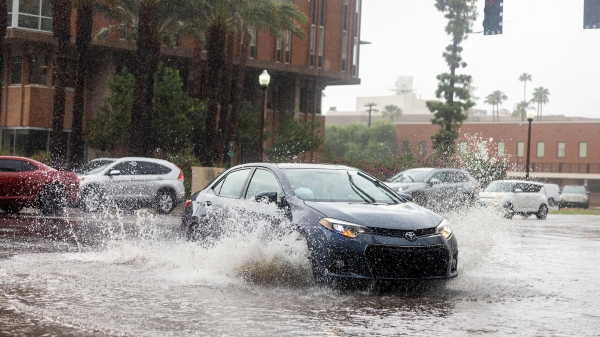ASU student teams design public art with garbage

The "Reduce, Reuse, Re: ASU" team won first place in a contest to create pop-up art installations out of garbage for Earth Month at ASU.
Three Arizona State University multidisciplinary student teams designed concepts around zero waste, the circular economy and public art. They unveiled their work as part of Earth Month with an installation at Neeb Plaza on April 13.
The event launched a monthlong rotation of pop-up public art installations on ASU's Tempe campus. Students, faculty and staff voted for concepts at the Point of Intervention Tour and the Digital Culture Showcase.
The Point of Intervention Tour was a signature Earth Month event hosted by Zero Waste to highlight circular resources. The Digital Culture Showcase is hosted by the SchoolThe school is a collaborative initiative between the Herberger Institute for Design and the Arts and the ASU Ira A. Fulton Schools of Engineering. of Arts, Media, and Engineering to display final projects.
The contest culminated the Creating Sustainable Experiences class, in which students “did weird things with garbage in public.” The goal of the class was to design public art pieces and engage the community with zero waste and circular resources.
The course is a collaboration between ASU’s Herberger Institute for Design and the Arts, School of Sustainability, University Sustainability Practices and the Zero Waste department. This semester’s course served as a pilot for future course collaborations between these partners.
Student winners designed public art out of items that may be defined as waste:
First place and $3,000 in scholarship
Team: Reduce, Reuse, Re: ASU
Participants: Stephanie Lemrise, design studies; Ashley Horton, justice studies; Samedi Johnson, digital culture
Second place and $1,500 in scholarship
Team: Polystyrene*: Object Permanence
Participants: Connor Damaschi, art (painting); Stephanie Hernandez, interior design; Hannah Wheeler, digital culture
Third place and $500 in scholarship
Team: The Permanence of Plastic
Participants: Emily Terpstra, Industrial Design; Gabrielle Honda, Interdisciplinary Studies; Benjamin Nandin, Digital Culture
Scholarships can be used at student’s discretion and may pay for supplies, course fees and tuition. Learn more about ASU’s collaborative action and zero waste sustainability goals.
More Environment and sustainability

From insects to mammals, the ASU Biocollections have it all — and are growing
Hojun Song has dedicated over two decades to studying locusts, grasshoppers, crickets and katydids — those jumping insects that…

How small behavior changes can make a big impact on food waste
Chris Wharton has spent the last 18 years researching diet and sustainability-related behavior changes. To some, the topics may…

Exploring the trickle-down effects of Arizona's fall storms
When rare bursts of rain sweep across the Valley, Arizonans can’t help but revel in the sound of thunder, the smell of wet…